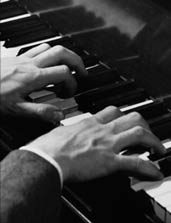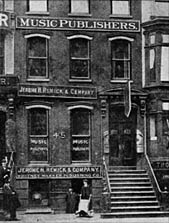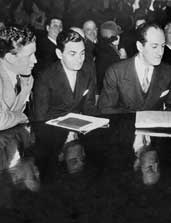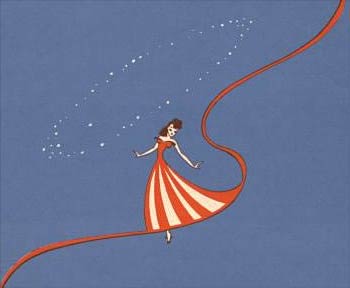Essay
Broadway & the Radio

Piano player
The 1920s saw the advent of three major advances in technology that would not only influence the quality of American domestic life but also reconstruct the entire edifice of show business: broadcast radio, electronic sound reproduction, and talking pictures. By the time the decade was over, the sound of America had completely changed. In 1920, two radio stations sprang up, carrying snippets of the news, and by 1926, the National Broadcast Company, operating out of New York City, started the first national broadcast — a variety show that was carried over two dozen affiliate stations across the country. By the end of the decade, 40 percent of all Americans had radio consoles in their homes; not surprisingly, the number reached 58 percent for households in New York City.

Tin Pan Alley
What Americans listened to most was music. Almost three quarters of radio programming was devoted to music, much of it classical, but popular music began making tremendous inroads over the airwaves. As the decade wore on and jazz became more popular, band performances were broadcast from Harlem’s Cotton Club and other metropolitan hot spots. Large sections of America were listening to black performers — to the extent that they were unaware of the musicians’ race — for the very first time. Of course, jazz and show tunes proved to be the lodestone of popular broadcast music.
Radio initially provided the young century’s second uppercut to the music publishing business of Tin Pan Alley. Gramophone recordings had severely undermined the sales of sheet music in the late 1910s, as the gramophone slowly replaced the upright piano in parlors across the country. By 1920, artists like Al Jolson and Eddie Cantor had achieved million-plus sales with their recordings of Broadway hit songs, far outpacing sheet music sales. Now, Tin Pan Alley considered itself lucky if a song sold 100,000 copies of sheet music. By 1925, advances in electronic sound recording allowed studios to get better range and fidelity in reproducing the work of their recording artists. Recording companies like Victor realized that the radio could be more friend than foe. Rather than squeezing out the popularity of a recording, if artfully promoted, radio could enhance the exposure of an artist or a song. So began the recording industry’s long and complicated affair with the broadcast media. “The music you want when you want it,” the industry trumpeted.

Rudy Vallee, Irving Berlin, and George Gershwin
The music that people wanted to hear was largely music from Broadway. That is not to say that other songs directly from Tin Pan Alley weren’t popular — novelty items like “Yes, We Have No Bananas” or “The Music Goes ‘Round and ‘Round,” which seem to have been invented solely to entice customers into buying them, filled the airwaves. But, for example, in 1927, out of the top 10 songs played on the radio, half were from Broadway shows: “Blue Skies” (“Betsy”), “Hallelujah” (“Hit the Deck!”), “Ol’ Man River” (“Show Boat”), “‘S Wonderful” (“Funny Face”), and “The Varsity Drag” (“Good News!”). Two others, “Me and My Shadow” and “Russian Lullaby,” were by Broadway composers. Back then, these songs were usually performed, or covered, by popular bands or crooners, rather than by original cast members, and many Broadway songs were rescued from obscurity by radio performers. Irving Berlin’s “Say It Isn’t So” languished until collegiate idol Rudy Vallee sang it repeatedly on his TV show; Walter Donaldson’s “My Blue Heaven” was such a big radio hit that Eddie Cantor interpolated it into the “Ziegfeld Follies of 1927.” When their songs weren’t filling the airwaves, the songwriters were themselves: Rodgers and Hart, Sigmund Romberg, and most successfully George Gershwin (incongruously promoting Feen-a-Mint Laxatives) hosted their own radio programs.

Detail of the sheet music cover page for Rodgers and Hart's "Bewitched, Bothered and Bewildered" from "Pal Joey."
But the voice that meant Broadway for Mr. and Mrs. North America was Walter Winchell’s. Show business ran so thickly in his blood, it’s a wonder there was any room left for hemoglobin. His Broadway column (originally in the tabloid GRAPHIC) doled out gossip, predictions, homilies, picks, and pans in staccato bursts, often with items separated by ellipses, or three dots. As a reviewer, he was a mediocre writer, but as a chronicler of his age, he was peerless. He brought his gift for hokum to the radio and became the most famous broadcaster of the lives and legends of Broadway. Eventually, he made the cardinal error of believing his own press, and his ego got him into some unseemly scrapes, but from the late ’20s through the World War II, he was the voice of the “Main Stem.”
In 1935, a radio show (and later television program) called “Your Hit Parade” enshrined the current popular song hits for a national audience. Many Broadway songs still found their way onto the Hit Parade, but there was now strong competition from Hollywood. Songs from the movies dominated the charts in the ’30s and ’40s, but there were occasional breakout hits from Broadway, such as Rodgers and Hammerstein’s “Oh, What a Beautiful Mornin’,” “If I Loved You,” “Some Enchanted Evening,” and “No Other Love.” Songs were usually covered by more than one artist; in a surprise to everyone in the business — including Richard Rodgers — “Bewitched,” from his 1940 hit with Lorenz Hart from “Pal Joey,” was recorded by nine different artists in 1950, turning it into a popular standard 10 years after the fact. Singer Rosemary Clooney had a huge hit with “Hey There” from “The Pajama Game” in 1954. Ironically, it was released two days before another hit single — Elvis Presley in his debut, singing “That’s All Right.” Presley, of course, signaled that rock ‘n’ roll was here to stay and, indeed, cut such a profound swath through the music industry that Broadway rarely had a Top Ten hit for the rest of the 20th century.
Photo credits: Photofest and the Library of Congress, Digital Imagery© copyright 2001 PhotoDisc, Inc.; and the Rodgers & Hammerstein Organization

